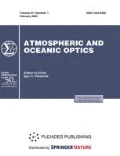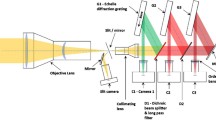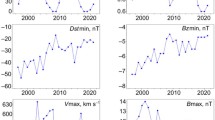Abstract
Variations in the OI 630 and OI 557.7 nm nightglow intensities in the midlatitude thermosphere during the geomagnetic storm of December 14–15, 2006, are analyzed. The analysis is based on optical, digisonde, and GPS observations for Eastern Siberia (52° N, 103° E). Simultaneous disturbances of variations, similar in amplitude and shape, in the emissions under study were observed during this storm. At the same time, the variations in the OI 630 and OI 557.7 nm airglow intensities correlated with the total electron content. It has been suggested that the 557.7 nm emission disturbances in this case can be caused by the O +2 dissociative recombination reaction and variations in parameters of the ionospheric F layer. To interpret the ratio of the observed OI 557.7 and 630 nm disturbed airglow intensities, we have simulated their altitude profiles.
Similar content being viewed by others
References
N. N. Shefov, A. I. Semenov, and V. Yu. Khomich, Airglow as an Indicator of the Upper Atmospheric Structure and Dynamics (GEOS, Moscow, 2006) [in Russian].
L. M. Fishkova, The Night Airglow of the Earth Mid-Latitude Upper Atmosphere (Tbilisi, Metsniereba, 1983).
K. Misawa, I. Nakeuchi, Y. Kato, and I. Aoyma, “Apparent Progression of Intensity Variations of the Oxygen Red Line,” J. Atmos. Terr.-Phys. 46(5), 39–46 (1984).
K. I. Kuz’min, “Oscillations of Intensity of 5577 and 5893 Å Emissions and Geomagnetic Activity,” in Aurora Polaris and Night Airglow (Nauka, Moscow, 1975), No. 23, pp. 28–32.
Yu. L. Truttse, “Upper Atmosphere During Geomagnetic Perturbations,” in Aurora Polaris and Night Airglow, No. 20 (Nauka, Moscow, 1973), Pp. 5–22.
S. M. Silverman, F. Ward, and R. Shapiro, “the Correlation between the 5577 Geomagnetic Activity,” J. Geophys. Res. 67, 2255–2264 (1962).
G. K. Mukherjee, “Airglow and Other F-Layer Variations in the Indian Sector During the Geomagnetic Storm of February 5–7, 2000,” Earth Planets Space 58, 623–632 (2006).
L. A. Leonovich, A. V. Mikhalev, and V. A. Leonovich, “The 557.7 and 630-nm Atomic Oxygen Midlatitude Airglow Variations Associated with Geomagnetic Activity,” Atmos. Ocean. Opt. 24, 396 (2011).
T. J. Fitzgerald, “Observations of Total Electron Content Perturbations in GPS Signals Caused by a Ground Level Explosion,” J. Atmos. Sol.-Terr. Phys. 59, 829–834 (1997).
B. Hofmann-Wellenhof, H. Lichtenegger, and J. Collins, Global Positioning System: Theory and Practice (Springer-Verlag, Wien, New York, 1992).
D. M. Horan and R. W. Kreplin, “Simultaneous Measurements of EUV and Soft X-Ray Solar Flare Emission,” Solar Phys. 74, 265–272 (1981).
http://sgd.ngdc.noaa.gov/sgd/jsp/solarindex.jsp (Solar-Geophysical Data)
K. Misawa, I. Takenchi, Y. Kato, and I. Aoyma, “Intensity Covariations of the Oxygen Green and Red Lines in the Nightglow,” Ann. Geophys. 37, 549–555 (1981).
F. C. Meneses, P. Muralikrishna, and B. R. Clemesha, “Height Profiles of OI 630 nm and OI 557.7 nm Airglow Intensities Measured Via Rocket-Borne Photometers and Estimated Using Electron Density Data: A Comparison,” Geophys. Int. 47, 161–166 (2008).
A. Omholt, “The Optical Aurora (Springer-Verlag, New York, 1971; Mir, Moscow, 1974).
M. N. Vlasov, M. J. Nicolls, M. C. Kelley, S. M. Smith, N. Aponte, and S. A. González, “Modeling of Airglow and Ionospheric Parameters at Arecibo During Quiet and Disturbed Periods in October 2002,” J. Geophys. Res. 110, A07303 (2005). doi: 10.1029/2005JA011074
D. Kella, L. Vejby-Christensen, P. J. Johnson, H. B. Pedersen, and L. H. Andersen, “The Source of Green Light Emission Determined from a Heavy-Ion Storage Ring Experiment,” Science 276(5318), 1530–1533 (1997).
A. E. Hedin, M. A. Biondi, R. G. Burnside, G. Hernandez, R. M. Johnson, T. L. Killeen, J. W. Meriwether, J. E. Salah, R. J. Sica, R. W. Smith, N. W. Spencer, V. B. Wickwar, and T. S. Virdi, “Revised Global Model of Thermosphere Winds Using Satellite and Ground-Based Observation,” J. Geophys. Res. A 96, 7657–7688 (1991).
D. Bilitza, “International Reference Ionosphere 2000,” Radio Sci. 36, 261–275 (2001).
Author information
Authors and Affiliations
Additional information
Original Russian Text © L.A. Leonovich, A.V. Mikhalev, V.A. Leonovich, 2011, published in Optica Atmosfery i Okeana.
Rights and permissions
About this article
Cite this article
Leonovich, L.A., Mikhalev, A.V. & Leonovich, V.A. Upper atmosphere nightglow disturbances during the geomagnetic storm of December 15, 2006 over Eastern Siberia. Atmos Ocean Opt 24, 579–583 (2011). https://doi.org/10.1134/S1024856011060091
Received:
Published:
Issue Date:
DOI: https://doi.org/10.1134/S1024856011060091




